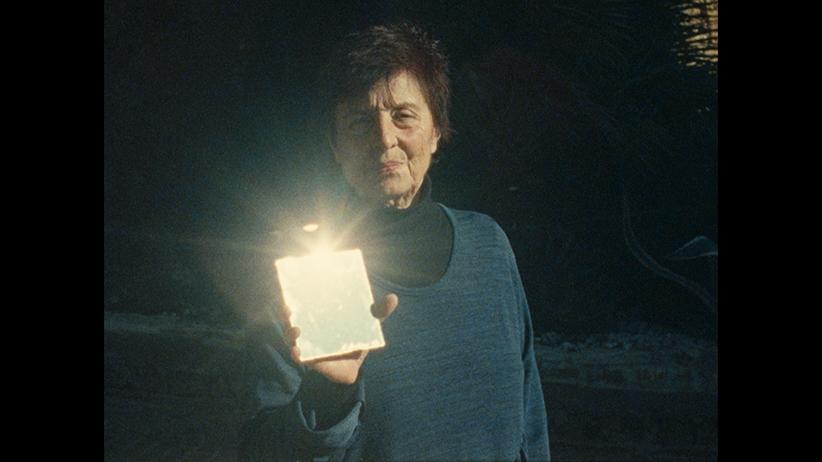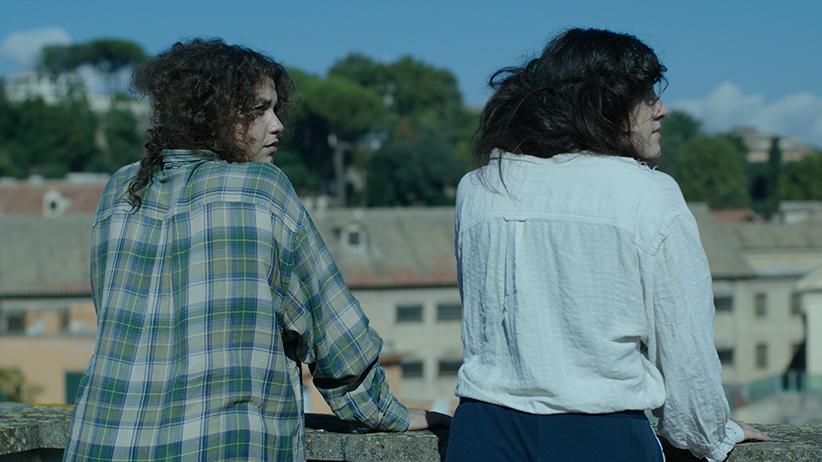È A QUESTO PUNTO CHE NASCE IL BISOGNO DI FARE STORIA
Die italienische Feministin, Autorin und Mitbegründerin von Rivolta Femminile, Carla Lonzi, widmete ihre letzten Lebensjahre der Recherche zu einer Gruppe französischer Protofeministinnen des 17. Jahrhunderts, bekannt als „Die Preziösen“. Dieses Projekt blieb nach ihrem vorzeitigen Tod im Jahr 1982 unvollendet. 1992 erschien die Publikation ARMANDE, SONO IO!, die Lonzis Aufzeichnungen, Gedanken und Entwürfe zur Geschichte dieser protofeministischen Gruppe dokumentiert.
Der Film nimmt dieses unvollendete Vorhaben zum Ausgangpunkt seiner Erzählung und berichtet von der Entstehungsgeschichte eines unwahrscheinlichen Fundes im Souterrain eines feministischen Zentrums in Rom: eine junge Filmemacherin entdeckt im Zuge ihrer Recherchen im Archiv eine verrottete Kiste, die Filmmaterial enthält, dessen Alter nach einer forensischen Untersuchung auf (unmögliche) 360 Jahre datiert wird. Während der Film die Entstehungsgeschichte dieses Fundes erzählt und ein fiktiver feministischer Radiosender namens RADIO DAFNE die Handlung kommentiert, wendet er seinen Blick zugleich auf Bruchstücke eines dunklen historischen Spiegels, in dem Fragmente einer Erzählung von Unterdrückung und Gewalt erscheinen, der Frauen über die Zeiten hinweg ausgesetzt waren. Diese werden in den Gegenentwurf einer Hommage an feministische, vor allem italienische Künstlerinnen seit dem 17. Jahrhundert bis heute integriert, welche alle in unterschiedlichen Beziehungen zu Carla Lonzi stehen – darunter Suzanne Santoro, Maria Grazia Chinese, Stephanie Oursler, Adriana Monti, Annabella Miscuglio, das römische Collettivo femminista cinema sowie Sappho, Artemisia Gentileschi und die venezianische Barockkomponistin Barbara Strozzi.
Die filmische Erzählung verwebt diese Elemente innerhalb einer Zeitreise, in der die Darstellerinnen verschiedene Rollen einnehmen: sie erscheinen unter anderem als Schauspielerinnen bei einem Casting, als Rachegespenster in einem Gefängnis, als „Preziösen“ des 17. Jahrhunderts, als Teilnehmerinnen einer römischen autocoscienza-Gruppe der 1970er Jahre und nicht zuletzt als sie selbst. In diesem zerfallenden Zeitkontinuum trifft Carla Lonzi in Palermo auf die Schauspielerin Armande aus dem 17. Jahrhundert: „È a questo punto che nasce il bisogno di fare storia“, es ist an diesem Punkt, dass der Wunsch entsteht, Geschichte zu schreiben – und zwar aus feministischer Perspektive. Aus jener zeigt sich „Geschichte“ als unvollendeter Prozess im stetigen Wandel, dessen Fragmente am Ende von den Frauen zu einem neuen Bild zusammengesetzt werden.
(Constanze Ruhm)
È A QUESTO PUNTO CHE NASCE IL BISOGNO DI FARE STORIA (Long Version)
The Italian feminist and author Carla Lonzi, a protagonist of the feminist revolts of the 1970s and 1980s, dedicated the last years of her life to researching a group of French proto-feminists of the 17th century, known as “Les Précieuses”. After her premature death in 1982, the project remained unfinished. In 1992, the publication ARMANDE, SONO IO! was published, documenting Lonzi's notes, thoughts and sketches on the history of this protofeminist group. Lonzi's interest in the history of “Les Précieuses” arose in connection with a personal crisis and against the background of her examination of gender relations and role models, but also with regard to her reflections on the feminist Roman collective Rivolta Femminile, which she co-founded. In her search for historical role models, the “Précieuses” seemed to her like an “echo of history”: a historical horizon and, at the same time, a real group of women with whom she could identify herself and Rivolta Femminile. This film takes Lonzi’s unfinished project as starting point and echo chamber for its narrative, in order to rethink it from a contemporary perspective, to highlight specific feminist experiences between three centuries and thus establish a historical continuity where none was (visible) before.
At the same time, it recounts the story of an unlikely discovery in the basement of a feminist center in Rome, the Casa internazionale delle donne. During her research in the center’s archive, a young feminist filmmaker finds a decaying crate containing film material, that, after forensic examination, is impossibly dated to be 360 years old. Meanwhile, a fictitious feminist radio station called RADIO DAFNE provides commentary on the plot, which also turns its gaze to shards of a dark historical mirror in which fragments of a narrative appear that tells of the oppression and violence to which women have been subjected over the ages. Quotes, re-enactments and original footage of the works of several feminist artists serve as material for the narrative and thus become elements of the plot. These include the publication ARMANDE, SONO IO! by Carla Lonzi (1992); two photographic objects from the series BLACK MIRRORS by Suzanne Santoro (1976); the photo book LA STRADA PIÙ LUNGA by Maria Grazia Chinese (1974); the artists' book UN ALBUM DI VIOLENZA and the brochure FIVE CUTS (both 1975) by Stephanie Oursler; the 16mm short film IL PIACERE DEL TESTO by Adriana Monti (1977); the Super8 films ANNA’S TEXTURES (1973-76) and FUGHE LINEARI IN PROGRESSIONE PSICHICA (1975) by Annabella Miscuglio; the feature-length film PROCESSO PER STUPRO (1979) by the Roman feminist collective Collettivo femminista cinema (Maria Grazia Belmonti, Anna Carini, Rony Daopoulo, Paola de Martis, Annabella Miscuglio, Loredana Rotondo) and paintings by the Italian Baroque painter Artemisia Gentileschi, which deal with the experiences of violence to which she was exposed. Further points of reference are the mythological figure of Echo the Oreade, the Greek poet Sappho and - on the level of film music - the Venetian baroque composer Barbara Strozzi with the composition “Che si può fare”, which became the starting point for the soundtrack composed by Gaël Segalen.
The idea to feature works of feminist artists from different generations links to the publication AUTORITRATTO by Carla Lonzi published in 1969. Author Giovanna Zapperi describes this publication as being made up by a series of interviews with artists conducted by Lonzi between 1965 and 1969, which were first recorded, then transcribed, only to be recomposed in a textual montage in which nothing remains of the continuum of the original exchange. (…) „The use of montage and the dimension of orality, exchange and sharing make AUTORITRATTO a highly experimental work, entirely permeated by the tension that animated Carla Lonzi at the time between her desire to renounce the authority of the critic and the affirmation of an authorial position capable of reinventing herself on the basis of this renunciation. Right from its title, AUTORITRATTO places the author's ego at the center, but does so from the horizontal, non-hierarchical relationship that develops with the other voices - those of the artists - involved in the book.“ [1] Thus, my film can also be seen as a portrait of Carla Lonzi taking the method established by Lonzi in AUTORITRATTO as its structure.
The artists featured in my film were all chosen, in various ways, in reference to Carla Lonzi. Despite occasional conflicts, Suzanne Santoro was close to Lonzi and Rivolta Femminile. Stephanie Oursler, a friend of Santoro, was also acquainted with that circle. Maria Grazia Chinese was an important ally of Lonzi, who published Chinese’s photo book LA STRADA PIÙ LUNGA through Rivolta Femminile’s publishing house. Adriana Monti, whose short film IL PIACERE DEL TESTO is re-enacted in the film, and Annabella Miscuglio, of whom original footage is featured, were contemporaries who worked on subjects closely aligned with Lonzi's interests.The relationship between Carla Lonzi and Artemisia Gentileschi here is primarily based on the concept of the self-portrait, which was significant in both Lonzi’s writing and Gentileschi’s painterly oeuvre. Interestingly, Gentileschi became a foundational figure for the feminist artists' collective Beato Angelico, which emerged from a split within Rivolta Femminile. This collective, founded by several feminist artists as an independent art space in Rome in the 1970s, featured a painting by Gentileschi in their inaugural exhibition.
All these elements are interwoven within a journey through time whose protagonists are constantly transforming: they appear as actresses at a casting; as vengeful ghosts haunting a former women's prison in Rome; as the French Précieuses of the 17th century; as feminist filmmakers and as participants in an autocoscienza group in Rome in the 1970s. In this disintegrating time continuum, Carla Lonzi meets the 17th century actress Armande in Palermo: “È a questo punto che nasce il bisogno di fare storia”, it is at this point that the desire to write history arises. The question of how to develop a new approach to feminist historiography is at the heart of Lonzis' research and therefore also of this film. It oscillates between fiction and reality, between real and invented documents (as “memory begins in an invented world”, as the Neapolitan feminist collective Le Nemesiache writes), and at the same time becomes an archive of feminist art itself.
Thus, a new and different relationship between past and present is created, which includes an experience that was previously considered worthless: that of women. By applying such a retroactive feminist gaze, “history” is reopened and appears as an unfinished, ever-changing process, whose scenes and images are reflected by the shards of a broken mirror (once the one that reflected the representations of women produced by patriarchy): Fragments that in the end are re-assebled by the women to form a new picture, one that remains in the dialectical space of promise and incompleteness, demanding another future. (Constanze Ruhm)
[1] Giovanna Zapperi, Il tempo del femminismo. Soggetività e storia in Carla Lonzi, 2015. Transl. by the author.
È A QUESTO PUNTO CHE NASCE IL BISOGNO DI FARE STORIA
2024
Österreich, Portugal
96 min



